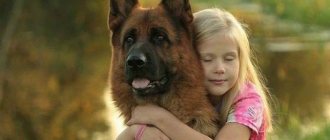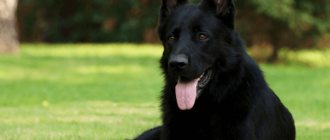How long does pregnancy last for a German Shepherd?
Dogs do not have an exact period for bearing puppies. The duration of these periods may vary depending on the individual and the number of fruits. The average gestation period for a German Shepherd is 60-65 days. There are some regularities:
- The duration of the first pregnancy is usually longer than subsequent ones;
- the more fetuses, the faster labor will occur.
The last week of a German Shepherd's pregnancy is considered important for the viability of the puppies. Babies born before the 53rd day do not survive. However, a prolonged pregnancy is also not the norm. If it lasts longer than 70 days, a caesarean section may be required.
The owner should write down how many days after mating the dog gives birth. This will help you understand how long your German Shepherd's pregnancy lasts and avoid unnecessary veterinary intervention. If the pet always gives birth after 70 days without compromising the health of the babies, it makes no sense to perform a cesarean section on the 65th day.
The duration of a German Shepherd's pregnancy is sometimes counted from the day of mating, but this is not always correct. Fertilization occurs 1-6 days after the female contacts the “groom”. Experienced breeders try to breed a dog during ovulation.
Preparation for mating
Here the issue cannot be resolved “quickly”; you should approach it seriously and thoroughly. The chosen one must have a good gene pool for the next generation. First of all, pay attention to his psychological health, although huskies are peace-loving, there are exceptions; in any case, aggression is unacceptable.
The next point is physical condition, the male must run fast and have a strong body structure. Also, both parents should not have any kind of disease or even a predisposition to it.
If a pet, for example, is born with a predisposition to cataracts, then its parents, itself and its litter brothers and sisters are considered unsuitable for breeding. Unfortunately, not all breeders are conscientious. A lot of breeds were spoiled and eradicated due to the wrong selection of a pair, the dogs lost their characteristic features and one of the main differences - character - was destroyed.
Of course, such an important issue of mating is not limited to the selection of a partner. It is necessary to prepare the bitch, making sure of her ability and suitability for procreation, and choose the right time.
In order for a sufficient number of eggs to be formed, and most importantly, fertilized in the future, you need to choose the right moment for mating. As in many matters, there is no need to rush; even after 14 days from the moment of estrus, the animal is not always ready; in most cases, females are ready somewhere after 20 days, or even later.
Try to observe your pet, her behavior and expression of interest in individuals of the opposite sex. Before meeting a male dog, the pet must go to the veterinarian so that he can confirm the good condition of the bitch and give the go-ahead for mating. Such high-quality preparation will help bring strong and healthy offspring.
How to Prepare for a German Shepherd Giving Birth
Proper preparation for a joyful and important event is the key to a successful outcome of the birth; for this, the owner of a pregnant shepherd is recommended to perform the following steps.
The average gestation period for a German Shepherd is 63-65 days, although sometimes a female dog whelps after 58 or even 72 days. After mating, the owner must immediately mark the expected date of birth on the calendar.
Regardless of the method of keeping the dog, it is advisable that the pregnant bitch gives birth in a warm, dry room with an air temperature of 28-30C to avoid possible hypothermia of the newborn puppies. In this room, 10 days before the birth, it is necessary to properly build a maternity unit. This can be a collapsible playpen made of wooden panels measuring 2x2 m with a side height of 50-70 cm and an internal ledge along the entire perimeter. You can simply fence off a corner of the room in a warm, bright room, away from drafts and direct sunlight.
Before giving birth, one wall must be removed; it is not recommended for a dog in this position to take the barrier. At the bottom of the birth block you need to lay an oilcloth with any cotton fabric on top of it. The dog must be placed in the birthing unit a week before giving birth, otherwise at the crucial moment the bitch will simply end up giving birth in a prepared place and choose any secluded corner at her discretion.
Maternity unit made from scrap materials
Diet
A week before the long-awaited day, it is necessary to exclude meat and fish products, as well as salt, from the pet’s diet to prevent the occurrence of eclampsia, which is fraught with premature or pathological birth.
The owner of a pregnant dog needs to prepare medications and supplies in advance in order to help the shepherd and her puppies in time.
During childbirth you may need:
- dry sterile diapers or pieces of cotton fabric;
- cotton wool;
- sterile petroleum jelly;
- gloves and syringes;
- infrared lamp or heating pad;
- box for newborns;
- pen and notepad;
- disinfected surgical scissors;
- gray and colored threads;
- scales;
- hydrogen peroxide solution;
- glucose and calcium gluconate;
- oxytocin;
- iodine;
- carvalol;
- cordiamine;
- goat milk;
- pipettes;
- drinking water;
- meat broth.
It is highly not recommended to transport dogs in the event of an unforeseen situation at the time of birth of puppies. It is advisable that emergency assistance be provided to the dog at home. To do this, you should agree in advance with an experienced specialist about the possibility of providing assistance at any time; most often, dogs give birth in the evening or at night.
Age at which German Shepherds can become pregnant
Animals of the German Shepherd breed are medium-sized dogs, and all large pets usually bear large offspring. In order to bear such a number of puppies and safely give birth, and subsequently feed them, the female must be fully sexually mature.
Thus, a pet that has reached the age of two and has gone through its first two heats is ready to participate in mating and subsequently bear and give birth to puppies. Early matings of shepherd dogs during their first or second heat are not allowed. At this time, the female has not yet fully formed. Early pregnancy will completely stop its growth and development. In addition, puppies will not get everything they need from their mother's milk.
Experienced breeders who value their pets usually do not breed dogs every time they come into heat. Maximum allowed to knit it once a year. But even in this mode, the animal’s body literally works “for wear and tear.” Dogs older than 6-8 years should not be allowed into breeding. In addition, you need to monitor the condition of your pet. If there are any health problems, it is better to avoid the planned mating and restore all life processes.
Pregnancy in German Shepherds is possible during puberty. This age occurs quite late in representatives of large breeds. The female takes up to 15 months to develop; early pregnancy will harm both the mother and the puppies.
Cynologists recommend that the first mating be carried out during the third estrus at the age of 1.5-2 years. The reproductive period lasts until the German Shepherd is 4-6 years old. No matter how many pregnancies a female endures, this is a heavy burden on her body, so breeders try not to breed a pet more than once a year so that her health can be restored. But even with such frequency, internal reserves are depleted, so breeding females over the age of 8 years is not recommended.
How many puppies can German Shepherd dogs have during pregnancy? In each litter, 6-7 babies are born, some females have 10-12 or even 15. In primiparous women, the litter is usually not numerous.
Further care
At the end of the birth process, you should carefully wash the “female organs” of the “woman in labor” so that there is no irritation of the mucous membranes, and wipe it well, then take her for a walk. It’s a good idea if during the walk one of your relatives or your assistant cleans the rodbox by changing the bedding. Cotton is optimal for replacement bedding: easy to wash, quick to dry. Other fabrics are not so hygienic.
There is a misconception that newborn puppies do not need care: “the dog will do everything on its own.” She will do a lot, but she will also need from you:
- monitor the air temperature in the “birth block” (it should be at least 28°C) and the cleanliness of the bedding;
- Take care to remove dewclaws from puppies - this is a must; in the future, both the dewclaws themselves and the claws on them that do not wear off will cause injuries;
- track the process of titanium: stronger and more active puppies often push weaker ones away from the nipples, and they weaken even more. In such a situation (also with a large litter), it is necessary to transfer the malnourished to partial “artificial feeding” - supplementary feeding, goat’s milk is suitable;
- trim the baby’s claws to avoid injury to the belly; if the nipples are cracked, lubricate them with healing oil;
- When the puppies open their eyes, you need to track their movements - they will be drawn to “travel”, exploring their surroundings. Eliminate all likely sources of injury;
- from two weeks of age, introduce complementary foods for adults (if you feed dry food, for puppies).
Before two months of age, it is not recommended to separate puppies from their mother, much less sell them. From 2 months, babies are gradually introduced to regular food.
“Shepherd owners” are lucky with the breed - a healthy dog usually does not require much trouble during childbirth (there are breeds whose labor is complicated due to body type or typical genetic health problems). With an attentive and loving owner, even in the case of a difficult birth of a German Shepherd, everything ends well: the main thing is timely and professional assistance. Do you remember your veterinarian's phone number?
German Shepherd pregnancy by day
Until the fifth week, it is impossible to notice that the dog is expecting puppies. In the first days of pregnancy, sperm move towards the gamete for fertilization. On about the fourth day they meet. At the end of the first week, the zygote moves into the uterus.
READ False pregnancy in a cat: how to avoid complications
The embryos are attached to the walls of the uterus by the end of the second week, but their size is still very small. From the 15th day, the organs of future puppies are formed. On the 16-17th day their size is one millimeter. The torso, spine, head, and central nervous system develop.
In the third week, the placenta is formed, but the embryo at this time is no more than 0.5 cm, it has a heart. By the end of the first month, the embryo grows to 2 cm.
Starting from the 22nd day, you should change the dog’s diet. At this time she may have morning vomiting. Until the 32nd day, the fetus grows the size of a nut, its teeth are formed, and all parts of the body are supplied with calcium.
From the 32nd day the second half of pregnancy begins. Embryos at this time reach a length of 3 cm, their weight is 20% of the weight of a newborn puppy. From the 5th week the dog has a noticeable belly and an increased appetite.
At the sixth week, all organs and bones are formed in puppies. By the 40th day, their size is about 6.5 cm. The uterus occupies almost the entire abdominal cavity. On the 41st-44th day, the puppies can be palpated.
From the seventh week, the female prepares a “den” for the babies. On the 45-49th day, the fruits reached a length of 9 cm.
From the 51st day milk may be released. In the eighth week, the female’s belly has increased significantly, and the dog moves with difficulty, trying to rest more.
Starting from the 58th day, the owner needs to be ready to give birth at any time. By the 60th day, the babies are completely covered with hair and are ready to be born.
A day and a half before giving birth, the female’s behavior changes. She hides in a secluded corner, arranges a nest, and seeks the owner’s attention. The folds on the genital loop disappear and mucous discharge is observed.
Immediately before giving birth, females' temperature drops. If the owner measured it daily, then its decrease to 36.6-37.1 ° C will indicate that in 18-24 hours the cherished moment of the appearance of the babies will come.
The weight of newborn puppies is 300-500 grams, length - 18-22 cm.
Signs of labor in a German Shepherd
Visible signs of pregnancy usually appear in the fifth or sixth week (especially if a large litter is expected): the sides increase, the dog becomes rounded in the rib region, the skin around the nipples brightens, begins to sag in small folds - so-called “beds” appear, the mammary glands increase in size , become softer.
Some animals pluck the hair around their nipples with their teeth. In the seventh week, fetuses can be easily felt in the horns of the uterus. In the last week, the stomach drops, you can see or feel with the touch of your hand how the puppies move in the mother’s stomach, “lining up” before being born. Milk begins to be released 4 - 5 days before whelping, but sometimes (especially in females who have not given birth) it appears immediately before giving birth.
You can determine the approach of the long-awaited moment by changes in the appearance and behavior of the German Shepherd before giving birth.
Change in appetite
In the last weeks of pregnancy, the animal begins to sort through food; a couple of days before giving birth, some individuals completely refuse food and water.
Refusal to eat in the last days of pregnancy indicates the approach of labor
Descent of the abdomen
Shortly before the crucial moment, the rounded belly drops down, and deep depressions appear on the dog’s sides, as if the pet is severely exhausted. This phenomenon is absent in primiparous bitches.
Anxiety
As the puppies move towards the birth canal, intra-abdominal pressure occurs, causing pain and discomfort to the pregnant female, body tremors and rapid breathing are observed. The dog tries to be alone, it can whine, tear the bedding, linoleum, furniture; animals are most worried during the first birth. It is impossible to scold or punish an animal in such situations; stress can cause premature birth and death of puppies.
Vaginal change
As the baby approaches the birth, the vulva becomes enlarged and swollen; it becomes soft, moist and loose.
Plug coming out
When the cervix opens, a mucous plug of gray, white or greenish color is released, which indicates that labor is approaching. During pregnancy, the cork served as a natural barrier protecting the fetus from infection from the outside.
The day before birth, under the influence of hormones, the rectal temperature decreases to 37C.
Swelling of the nipples
Shortly before the birth of babies, and in firstborns just before birth, the mammary glands become enlarged, the nipples swell, and sometimes colostrum is released.
It happens that in the fifth week after estrus, a dog’s behavior changes. This can happen in two months. If there was no mating, it means there is a hormonal imbalance.
If mating was carried out, then the reason for this behavior may be the death of the fetuses for up to 4 weeks.
Some females have a predisposition to the occurrence of this condition, and they are able to feed other people's cubs.
- The dog makes a nest and nurses stuffed animals (or other objects) like puppies, protecting them.
- Expresses anxiety, refuses to go for walks, hides, whines.
- Her mammary glands enlarge and milk may be released from them.
- To help the dog, you should hide all the “puppies” when the dog is on a walk, and show the pet to the veterinarian.
The condition itself is not dangerous, but can cause mastitis.
False and frozen pregnancy
The so-called false pregnancy is not a disease, but is one of the complex psychophysical abnormalities with pathological consequences. Despite the fact that false pregnancy can occur in different species of animals, it is the canids that suffer from this disorder most often. False whelping appears after estrus, about one to two months, and can also be the result of unsuccessful mating. In this case, the shepherd’s body produces a standard set of hormones, which are normally produced in a dog only during real pregnancy.
The main physiological symptoms of false pregnancy in a German Shepherd are presented:
- swelling of the mammary glands;
- production and further secretion of colostrum or milk;
- enlargement and swelling of the vaginal loop;
- serous-mucous or brownish discharge from the vaginal loop;
- decreased or increased appetite;
- signs of toxicosis;
- noticeable increase in body temperature;
- slight increase in abdominal volume;
- possible signs of false labor with pseudocontractions.
Specific behavioral signs of false pregnancy include:
This is interesting! If we do not take into account some historical prerequisites for the appearance of hormonal false pregnancy, then the main cause of this condition is represented by disturbances during the standard sexual cycle of the dog.
Sometimes one or several embryos stop in their development and quickly die, which can be caused by infections, developmental pathologies, hormonal disorders and other reasons. A frozen pregnancy can be diagnosed not only symptomatically, but also during an ultrasound examination. Frozen fetuses are most often expelled from the dog’s uterine cavity without outside help in the process of spontaneous miscarriage.
Caring for a pregnant female
As mentioned earlier, from the fifth week, signs of pregnancy in a German Shepherd are visible even to an inexperienced breeder. Among them:
- Rounded belly. The female may look like an overweight dog. But if the pregnancy is multiple, the stomach becomes pear-shaped and droops.
- The mammary glands change color and enlarge. Their skin darkens, by the fifth week they swell, and by the seventh week the hair around them falls out. The dog can lick its belly itself. A few days before birth, milk is formed in the glands, sometimes dripping.
READ German Shepherd Puppy Height and Weight
Pregnancy of a German Shepherd, an active and mobile dog, is not a reason to refuse walks. The first month may well pass as usual. Then the walks should be long but calm. The pet is not allowed to jump or play with other four-legged animals. Meetings with sick animals are dangerous. In summer it is dangerous to overheat, so walks are taken early in the morning or in the evening.
Activity during pregnancy is necessary to maintain muscle mass and not gain excess weight. Obesity can significantly complicate the birth process: contractions will be weak and oxytocin will be required.
A pregnant female may discharge mucus from the birth canal. If the dog does not lick it on its own, the owner should help it by using a napkin.
It may happen that the female relieves herself in the apartment, this often happens during pregnancy, you should not scold her, because at this time it is difficult for the dog to control this process.
Closer to the birth, the owner needs to organize a place for the puppies and their mother. This should be a comfortable corner without drafts and unnecessary noise. You should not allow your pet to change this place.
Also, everything necessary for the birth process should be purchased in advance. The veterinarian will tell you what medications to buy.
In order not to confuse babies, and to track weight gain and general development, it is worth tying ribbons of different colors immediately at birth
Newborn German Shepherd puppies are born blind and deaf, with soft, dark fur, long fur, and a large, rounded head. The normal weight of healthy babies at birth is 350-500 g. Caring for newborn German Shepherd puppies is quite troublesome; the owner needs to create safe and comfortable conditions for the growth and development of the young:
- the birth unit with puppies should be in a room with an air temperature of 28-30C, the bedding must be disinfected and washed daily;
- dewclaws are removed from newborn babies;
- The owner needs to ensure that all the babies are fed. Despite the fact that babies' eyes open only on the 10-15th day, newborn strong cubs quite actively find and fight for the mother's rear milk nipples, pushing away weaker brothers and sisters;
- with a large litter, it is recommended to feed the puppies in turn; well-fed puppies are put in a separate box for 2-3 hours, where they are fed with goat’s milk. An alternative option is to nurse with a foster lactating bitch;
- In the first week, babies should feed on breast milk at least 12 times a day, in the second week - 8 times, and in the third week - 4-5 times. Well-fed babies behave calmly and often sleep;
- German Shepherd puppies begin to hear only 12-15 days after birth, when newborns' eyes are already fully open. Full hearing develops only at the end of the first month of life. Sighted puppies begin to actively explore the world around them, so in order to avoid accidents, it is unacceptable for babies to leave the maternity ward at such an early age.
- once a week it is necessary to cut the claws of babies in order to avoid damage to the skin of the nipples of a nursing bitch; if cracks appear on the nipples, they must be lubricated with sea buckthorn oil or Vaseline;
- from 2 weeks it is necessary to feed babies with porridge, and from 3 weeks with calcined cottage cheese, raw scraped veal and rice water. It is necessary to give growing young animals vitamins A and D daily;
- It is recommended to separate puppies from their mother no earlier than 2 months, gradually replacing one feeding with adult food.
With careful preparation and study of the physiology of an important process, the birth of a German Shepherd ends in the birth of charming furry babies. German puppies are very cheerful, funny and inquisitive pets, which, with proper care and education, grow into true loyal friends.
What changes in the appearance of a pregnant shepherd?
As mentioned earlier, from the fifth week, signs of pregnancy in a German Shepherd are visible even to an inexperienced breeder. Among them:
- Rounded belly. The female may look like an overweight dog. But if the pregnancy is multiple, the stomach becomes pear-shaped and droops.
- The mammary glands change color and enlarge. Their skin darkens, by the fifth week they swell, and by the seventh week the hair around them falls out. The dog can lick its belly itself. A few days before birth, milk is formed in the glands, sometimes dripping.
How many puppies does a German Shepherd give birth to?
Most often, in dogs, labor begins late in the evening or at night, although the physiological process does not depend on the time of day. In German Shepherds, labor lasts on average 3-15 hours. The duration of birth of puppies directly depends on the number of babies in the litter. Childbirth usually lasts the same number of hours as there are newborns in the brood.
The process of childbirth begins with contractions, during which the contracting uterus expels the fetal bladder from its cavity. Contractions are manifested by convulsive muscle contractions, rapid breathing with an open mouth. Contractions are subsequently joined by painful pushing - contractions of the abdominal wall muscles, aimed at moving the fetus out through the birth canal. During pushing, the dog strongly strains its stomach, lifts its tail and stops breathing.
A pregnant female can give birth in a supine position, resting her limbs while pushing against the wall of the birth block or any solid object. Some dogs give birth while standing; in this position, the owner needs to take the newborns in his arms in time to avoid them falling.
The largest puppy is born first; it is highly not recommended to interfere with this process, which is the starting mechanism for the successful course of all births. The fetus moves along the birth canal in the membranes; immediately before birth, a water bladder with amniotic fluid bursts, facilitating the baby’s movement along the birth canal. After the water has drained, the puppy must be born no later than 2 hours later, otherwise the baby may suffocate.
The cub is born in the membranes, an experienced dog independently frees the baby from the membranes, the interval between the birth of the cubs can be from several minutes to an hour. The bitch gnaws the umbilical cord and licks the newborn, thereby massaging the intestines and stimulating the first act of breathing.
If he does not lick his puppies immediately after birth, the owner himself needs to rupture the fetal sac, cut the umbilical cord and clear the newborn’s nose and throat
Following the cub comes the afterbirth, rich in protein and hormones. The owner of a German Shepherd needs to control the number of pups and placenta born to prevent the development of endometritis. The shepherd dog should eat no more than 3-4 placentas to stimulate uterine contractions and breast milk production without developing diarrhea.
A German Shepherd in adulthood produces an average of 6-8 puppies, although a litter may consist of 1-14 newborns. Dogs have 5 pairs of nipples, so small litters are optimal for maintaining the health of babies. In the first litter, the bitch gives birth to 5-6 puppies. The size of the brood depends on the number of mature eggs in the body of the expectant mother at the time of mating.
Start of the process
If the bitch begins to tremble, her breathing quickens, it means that contractions have begun - contraction of the muscles of the uterus - with subsequent expansion of the birth canal. Then a “plug” comes out - a substance that protects the fruit from infections. Then the amniotic fluid leaves. When the interval between contractions becomes short and the dog calms down, pushing begins - contractions of the abdominal muscles, followed by the birth itself - the puppies come out one by one, with an interval of twenty minutes to three hours.
If the discharge has a bad smell, is green in color, the first puppy has still not appeared after three hours, and in general, if you have any suspicions that something is going wrong, call a doctor immediately.
When the birth is natural, the dog gives birth on her own, bites the umbilical cord and licks each puppy. The bitch can eat the afterbirth with a high content of useful substances after each puppy, but do not allow her to eat more than one or two so that she does not have diarrhea.
If she is having a hard time giving birth on her own, you will have to help. Carefully pull the puppy out and free it from the shell, tearing it near the muzzle. Cut the umbilical cord with sterile scissors, stepping back a couple of centimeters from the baby’s body, and tie it with alcohol-soaked silk thread. Then wipe the puppy with a cloth and put it in the box. Repeat the steps with each puppy.
If the puppy is born without signs of life, you need to suck out the mucus from his respiratory tract using a pipette. Then lightly massage his body to stimulate breathing and circulation.
If more than three hours have passed since the birth of the next puppy, it means that the birth is over and you can give the Yorkshire terrier bitch a drink of warm tea with milk or fermented milk porridge. After an hour, take your dog out for a walk so he can go to the toilet. When labor is over, place the new mother and her newborns in the delivery box.
How to help a German Shepherd during labor
You should not interfere in the process of a successful birth; the owner should only support and reassure the pet with gentle words.
READ How to name a pig beautiful names for pigs
The minimum help is to cut off the umbilical cord with sterile scissors 3 cm from the newborn’s body. But a dog and its babies truly benefit from human intervention in the following situations.
It is necessary to independently rupture the membranes, cut the umbilical cord, free the baby’s nose and mouth from mucus with a gauze cloth, massage the tummy with a damp swab and clean the anus of meconium, after which it is advisable to place the puppy to the mother’s face for licking.
The dog has no milk
Sometimes the baby is born, but colostrum has not yet been produced. In such a situation, it is necessary to feed the baby warm goat milk from a syringe. It happens that the puppy cannot suck on his own. In order to help the baby, it is recommended to squeeze a drop of milk onto the nipple, then put it into the baby's open mouth. The baby should latch on and eat.
Before giving birth, you should purchase goat milk and pipettes in case the mother does not have milk.
Bitches giving birth for the first time may experience a lack of maternal instinct, postpartum shock, or increased licking of the belly; all these psychological disorders can cause the death of the entire litter. If the mother crushes or gnaws the newborns, it is necessary to urgently transfer the babies into a box under a lamp and remove them from the nest.
Perhaps, having recovered from the shock, the mother will accept and feed her children. But most often in such situations, it is recommended to find a nursing foster mother and show the woman in labor to a specialist to determine why the German Shepherd eats its puppies. Perhaps the cause is hidden pathologies, vitamin deficiency, early or late pregnancy, lack of nutrients.
You can take the dog outside for a short jog, drink cold sweet tea or meat broth, after which you can massage the abdomen in the direction from the hips to the pelvis and internal massage of the vagina.
Depending on the presentation, they fix it with two fingers and lubricate the emerging part of the body with sterile Vaseline, then carefully pull out the newborn in time with the attempts.
Mating
Usually the bitch is asked to be brought to the male, since the male feels much calmer in his territory and does not require more time to get used to. If the animals have not met each other before, then it is better to be present for some time to make sure that they get along. In general, “Chukche dogs,” guided by their instincts, cope without human intervention, unlike many other dogs. Sometimes the owner holds the female.
Some breeders still prefer to be present during the mating process - in this matter the decision is yours. Often, after the first time, a repeat visit is made, this prevents the possibility that not all eggs are fertilized. But this trip is already the choice of the expectant mother.
Do not make any decisions before 72 hours, this is when sperm is active. During this couple of days, it is recommended to observe your household, namely, the manifestation of activity towards male dogs. If the pet resists re-breeding, then you should not do this. Otherwise, another meeting is possible.
Diagnosis of pregnancy
If the dog is truly pregnant, the breeder should contact a veterinarian as soon as possible. Pregnancy is usually determined by ultrasound from the 4th week, but some veterinarians can do this on the 21st day.
The number of puppies can be found out on the 48-50th day.
An ultrasound should be performed if the dog’s condition worsens, vomiting occurs, the female refuses food, and is in a depressed state. The examination will help determine whether the puppies are alive. If the pregnancy has frozen or the fetuses have died from hypoxia, urgent medical intervention will be needed.
Childbirth
About a day before the birth of the offspring, the mother stops eating and looks for a suitable place. This is usually a secluded, semi-enclosed space. The dog sometimes brings his own bedding or blanket there.
But the place chosen by the animal is not always convenient for the breeder, so he must arrange and provide a secluded corner with his own hands. For those who don’t like to “bother too much,” so-called “maternity boxes” are available for sale.
It is better to lay a foam bedding inside, so that it would be more convenient for future newborns to cling to when they look for their mother. Before labor itself begins, prepare a box containing a heating pad covered with a towel. You will also need to keep a basin of hot water and a clean towel ready.
When the process has begun, you need to be present, be close to the bitch and “keep your finger on the pulse of events.” Excessive excitement and panic are not appropriate here; you must be collected and control the situation. Fruits can appear at different intervals, either every 15 minutes or an hour.
The pet, having given birth to a baby, gnaws the umbilical cord itself and gets rid of the placenta by eating it. You become witnesses to that exciting moment when puppies open their eyes, looking at this world for the first time.
Place newborns in a prepared box with a warm heating pad, as they are not yet able to maintain their own body temperature and cool quickly. If the animal pushes for more than two hours, it is necessary to call a veterinarian, since the lives of both the female and her children are in possible danger. As soon as you are convinced that the woman in labor has completely whelped, the bitch should, perhaps even forcefully, be taken out for a short walk so that she can defecate, and subsequently, she and her offspring should be shown to the veterinarian.
The babies will need to be wiped with a towel, dipped in water prepared in advance, and carefully clean their eyes, and then returned to the mother. You should not take puppies away from your husky and interfere too often; she may not like it. But the pleasant worries do not end there; many more joys and troubles await you as the little representatives of this breed grow up.
Education
University: Moscow State Academy of Veterinary Medicine. Year of graduation: 2010. Specialty: Veterinary medicine, Veterinary medicine.
Experience
I have more than 7 years of experience working in a veterinary clinic.
experience
FSBI "All-Russian State Center for Quality and Standardization of Medicines for Animals and Feed"
Useful materials:
- Cutaneous horn General description of the disease Cutaneous horn on the forehead or face (ICD 10 code - L57.0) -...
- Itching and odorless discharge Main causesBefore considering the factors that provoke the appearance of discharge that has a sour odor, it is necessary to immediately note...
- Normal temperature in animals Normal temperature in different types of animals Veterinary services Day hospital for animals Veterinary certificates Vaccination…
- Conjunctivitis in a dog Catarrhal conjunctivitis The causes of catarrhal conjunctivitis, as a rule, can be: Contact allergies, trauma, food allergies (for example, to ...
Visible signs of pregnancy in a dog.
A pregnant shepherd needs proper care. Typically, such a condition is planned long before its onset. If a female is carrying babies, it is undesirable to use any medications. All chronic diseases must be treated in advance. In addition, you need:
- get all vaccinations at least a month in advance;
- carry out deworming a week before mating;
- during the warm season, select antiparasitic agents approved for pregnant females.
After mating, the dog is considered pregnant, and although food and exercise do not change in the first month, it must nevertheless be handled with care, giving plenty of rest.
After the birth of the babies, the owner must create optimal conditions for the mother to restore her strength and raise furry babies:
- It is necessary to wash the animal's fur and walk the dog for a long time in an apron that protects the mammary glands and open birth canal from infection. After each walk, you need to wipe the mother’s paws and belly to avoid infection of the babies;
- during a walk, you need to change the dirty bedding, examine and weigh all newborns;
- if the dog is breathing heavily, there is drooling, rapid heartbeat, increased body temperature, purulent discharge from the uterus, it is urgent to give the dog Carvalol or Cordiamine and call a veterinarian at home;
- Cotton bedding for newborns should be changed daily, subjecting them to disinfection, washing and ironing;
- For several days after giving birth, you should ensure that the bitch does not bite or crush the babies, that the cubs are fed and are located near the mother’s body;
- If puppies squeak all the time and sleep little, most likely they do not have enough mother’s breast milk. In this case, it is necessary to introduce lactogenic additives into the diet of the lactating bitch and feed the babies with goat’s milk;
- A nursing bitch must be fed a highly nutritious diet with increased protein and calcium content. It is also necessary to ensure that the dog always has a full drinking bowl to replenish lost fluid.
Babies sleep a lot and squeak little if they are full
What to feed?
A pregnant dog's weight increases by 10-25%. At the same time, in addition to the fruits, nutrients are deposited for the mother herself during the lactation period. Therefore, her diet, starting from the second half of pregnancy, should be 1.5-2 times higher in calories than usual.
It is also important to follow a number of recommendations:
- Do not feed your dog expired or low-quality products.
- Cook the meat thoroughly.
- Do not give food that causes bloating - brown bread, legumes, potatoes.
The diet of a pregnant dog includes foods high in protein - lean meat, cottage cheese, as well as cereals (buckwheat, rice), boiled vegetables (carrots, pumpkin, zucchini). Be sure to add vitamin and mineral supplements.
If the pet is kept on ready-made industrial food, then from the second half of pregnancy and throughout lactation, puppy food is used for up to two months.
From the fourth week of pregnancy, the female is transferred to 3 meals a day, from the seventh - to 4 meals a day, in small portions. A week before giving birth, the dog is not given meat, replacing it with fish and cottage cheese. This is necessary to prevent eclampsia - a special form of toxicosis in the form of seizures.











